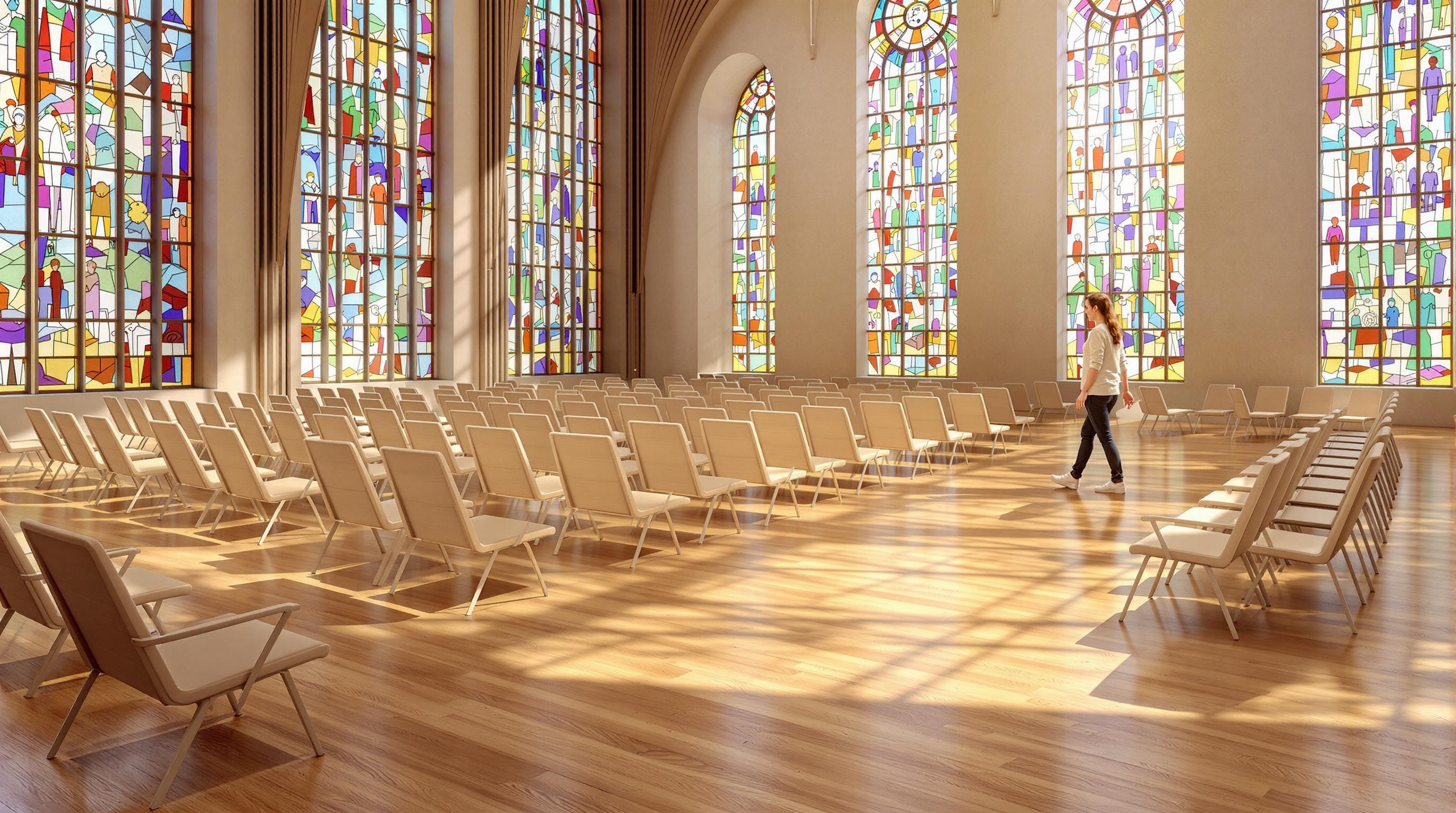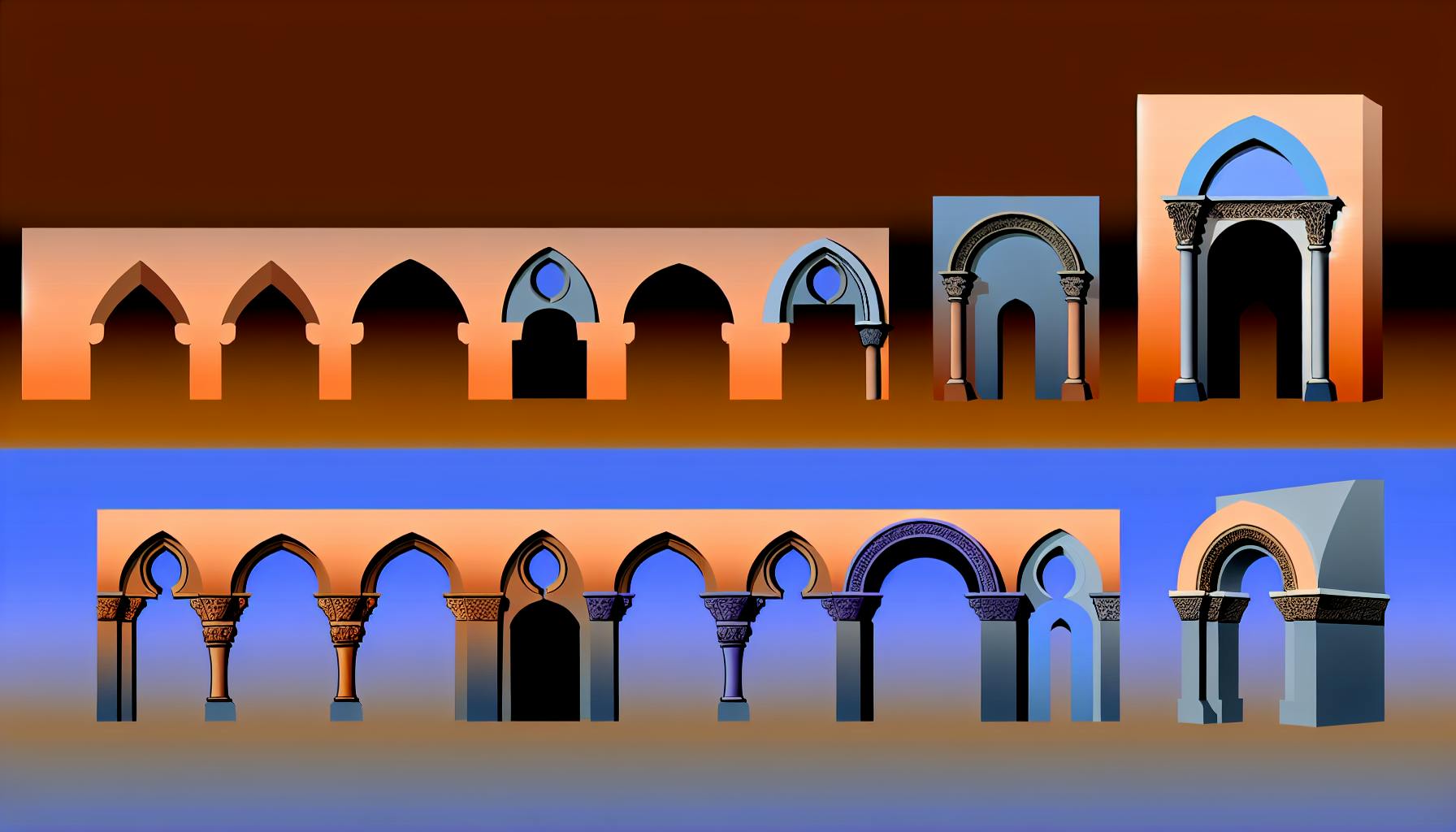New York City's skyline is iconic, featuring a mix of architectural marvels that define the city. Here's a quick rundown of 13 famous NYC buildings:
-
Empire State Building (1931): 1,454 feet tall, Art Deco style
-
Chrysler Building (1930): 1,046 feet tall, known for its distinctive spire
-
One World Trade Center (2014): 1,776 feet tall, tallest in Western Hemisphere
-
Statue of Liberty (1886): 305 feet tall, symbol of freedom
-
Flatiron Building (1902): Unique triangular shape, 285 feet tall
-
Guggenheim Museum (1959): Spiral design by Frank Lloyd Wright
-
Grand Central Terminal (1913): Beaux-Arts landmark, famous for its celestial ceiling
-
St. Patrick's Cathedral (1879): Neo-Gothic church on Fifth Avenue
-
Metropolitan Museum of Art (1880): Vast collection spanning 5,000 years
-
Brooklyn Bridge (1883): Iconic suspension bridge, 1,595.5 feet long
-
Rockefeller Center (1930-1939): 22-acre complex with observation deck
-
The High Line (2009-2014): 1.5-mile elevated park on former railway
-
United Nations Headquarters (1952): Home to global diplomacy
| Building | Height (ft) | Year Built | Key Feature |
|---|---|---|---|
| One World Trade Center | 1,776 | 2014 | Tallest in Western Hemisphere |
| Empire State Building | 1,454 | 1931 | Art Deco icon |
| Chrysler Building | 1,046 | 1930 | Distinctive spire |
| Statue of Liberty | 305 | 1886 | Symbol of freedom |
| Flatiron Building | 285 | 1902 | Triangular shape |
These buildings showcase NYC's architectural evolution from the late 19th century to today. Each has a unique story and design, contributing to the city's famous skyline and cultural identity.
Related video from YouTube
How This List Works
This list covers 13 of NYC's most famous buildings. For each, you'll find:
-
Address
-
Historical background
-
Key architectural features
-
Visitor tips
Here's a sneak peek at three buildings:
| Building | Height | Year Built | Highlight |
|---|---|---|---|
| Empire State Building | 1,454 ft | 1931 | Two observation decks |
| One World Trade Center | 1,776 ft | 2013 | Tallest in Western Hemisphere |
| Statue of Liberty | 305 ft | 1886 | Copper statue from France |
Each description captures why the building is a must-see NYC landmark.
Pro tip: Many buildings are on attraction passes. For popular spots, book online to skip lines.
Ready to explore the buildings that define NYC's skyline? Let's go!
Empire State Building

The Empire State Building isn't just a skyscraper. It's THE skyscraper. Standing tall in Midtown Manhattan, this 102-story giant has been wowing visitors for decades.
Quick Facts:
-
1,454 feet tall (with antenna)
-
Built in 1931
-
Art Deco style
-
102 floors (plus a secret 103rd!)
Here's something crazy: They built this beast in just 410 days. During the Great Depression! At one point, 3,400 workers were cranking out 4.5 stories a week.
Want to Visit?
You've got two observation deck options:
| Floor | Height | What You'll See |
|---|---|---|
| 86th | 1,050 ft | Open-air, 360° views |
| 102nd | 1,250 ft | Enclosed, panoramic views |
Ticket prices:
| Deck | Adult | Senior | Child | | --- | --- | --- | | 86th Floor | $44 | $42 | $38 | | Top Deck (102nd) | $79 | $77 | $73 |
Pro tips:
-
Book online
-
Go early (9 AM) or late (after 10 PM)
-
VIP Express Pass ($120+) lets you skip lines
Don't miss the exhibits on floors 2 and 80. They'll tell you all about the building's history and how it's shown up in over 90 movies. (King Kong, anyone?)
Fun fact: The architect, William Lamb, got ideas from buildings in North Carolina and Cincinnati.
Here's a plot twist: This icon wasn't always popular. In the 1930s, people called it the "Empty State Building" because no one wanted to rent space there.
But look at it now. In 2024, Tripadvisor named it the #1 Attraction in the World. Not too shabby for a building that's been around for almost a century!
2. Chrysler Building

The Chrysler Building is a New York City icon. Built in 1930, this Art Deco masterpiece at 405 Lexington Avenue still turns heads.
Key Stats:
-
1,046 feet tall
-
77 floors
-
Built 1928-1930
-
Art Deco style
-
$20 million price tag (1930)
What's special about it? It's not just tall—it's got style. The building is packed with car-inspired details, a nod to Walter P. Chrysler, its original owner.
Look for:
-
Eagle gargoyles (based on 1929 Chrysler hood ornaments)
-
Hubcap and fender designs on the facade
-
A shiny, stainless steel spire
Fun fact: That spire? It was a secret last-minute addition to beat another building in the "world's tallest" race. The Chrysler Building won... for 11 months.
Visiting:
| What | Details |
|---|---|
| Lobby Hours | Mon-Fri, 8am-6pm |
| Cost | Free |
| Best Views | Empire State Building or helicopter tour |
You can't go up to an observation deck anymore, but the lobby's worth seeing. Don't miss the ceiling mural by Edward Trumbull.
"The Chrysler Building is identifiable from any distance for its distinguishable style and profile against its surroundings." - Megan Sveiven, ArchDaily
This NYC symbol has starred in movies like "Spider-Man" and "Godzilla." It's more than a building—it's New York in steel and stone.
3. One World Trade Center
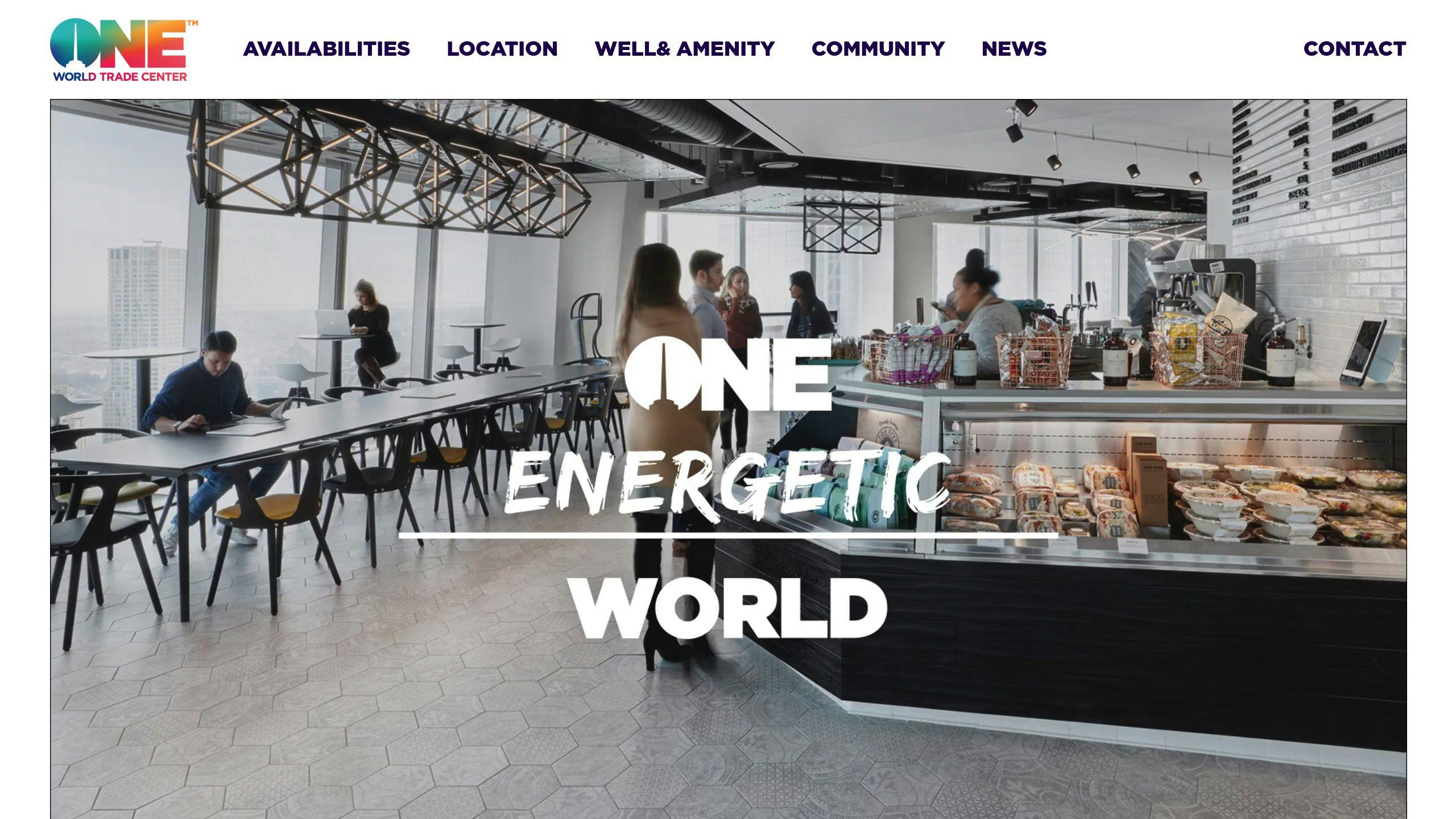
One World Trade Center is NYC's tallest building. At 1,776 feet, it's a symbol of hope built where the Twin Towers once stood.
Quick Facts:
-
1,776 feet tall
-
104 floors
-
Finished in 2014
-
Cost $3.8 billion
SOM designed it with a cubic base and slanted edges. The building's look changes as it reflects light throughout the day.
It's SUPER safe:
-
28-inch thick concrete walls at the base
-
Wide, pressurized emergency stairs
-
Extra-strong concrete and steel
Want a view? Head to One World Observatory on floors 100-102.
| What | How |
|---|---|
| Elevator | Ground to 102nd floor in 60 seconds |
| Observatory | 1,268 feet high |
| Food | Bar and café |
You'll see NYC's history and how they built the tower. The elevator ride shows 500 years of NYC growth in 60 seconds.
"One World Trade Center speaks about the future and hope as it rises upward in a faceted form filled with, and reflecting, light." - SOM
Pro tip: Visit during slow times and book online. It's easy to get to by subway in Downtown Manhattan.
One World Trade Center isn't just a building. It shows NYC's strength and looks to the future.
4. Statue of Liberty
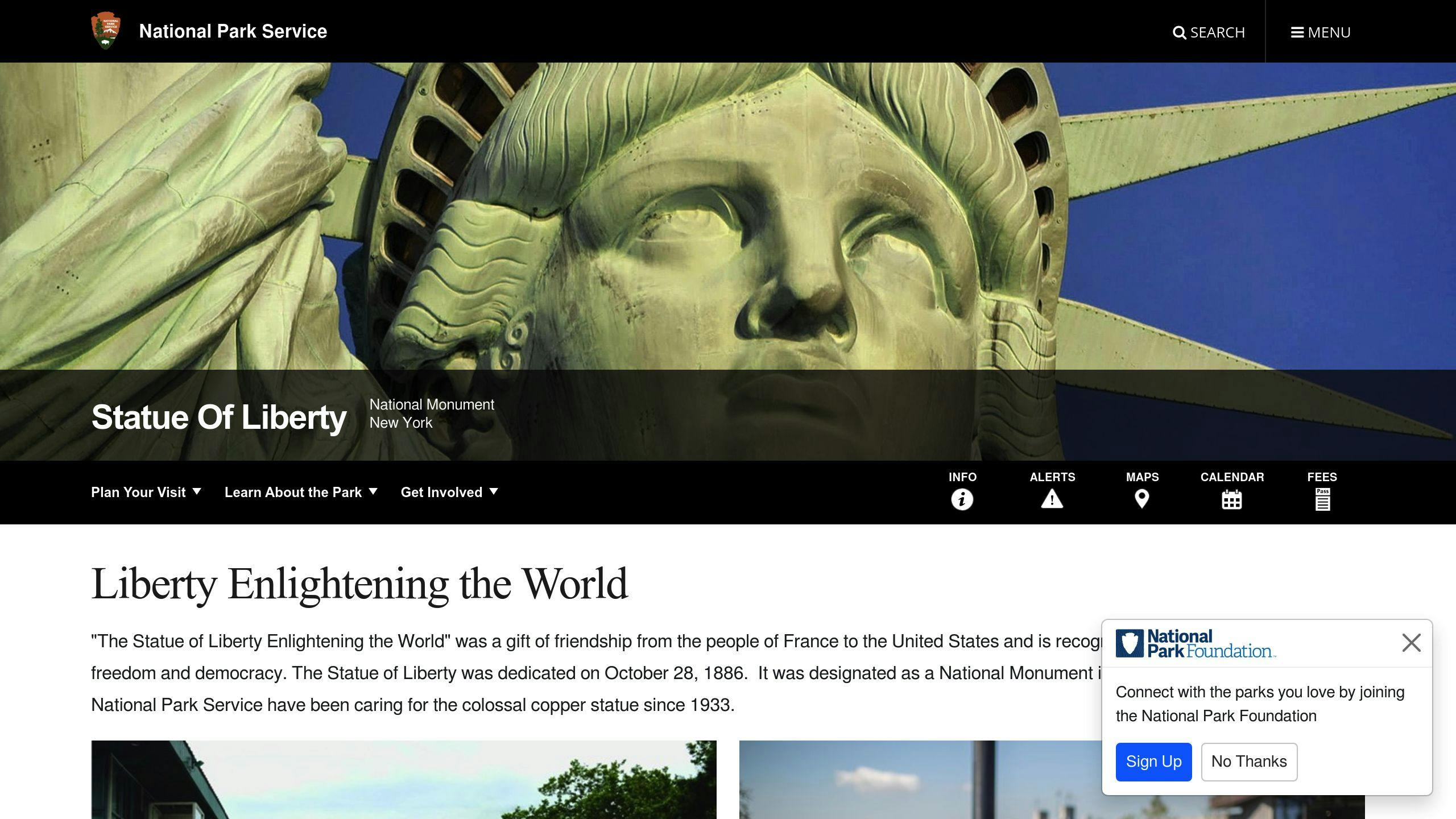
The Statue of Liberty stands in New York Harbor, a 305-foot copper giant welcoming visitors since 1886.
Quick Facts:
-
305 feet tall (with pedestal)
-
Weighs 225 tons
-
Dedicated: October 28, 1886
-
Gift from France to the US
Built in France and shipped to the US in pieces. French sculptor Frédéric-Auguste Bartholdi designed it, while Alexandre Gustave Eiffel (yep, the Eiffel Tower guy) made the metal framework.
What's She Holding?
| Item | Meaning |
|---|---|
| Torch | Freedom's light |
| Tablet | US independence date (July 4, 1776) |
| Broken chains | End of oppression |
Her crown has 7 spikes for the world's 7 seas and continents. And you can climb up there!
Visiting Tips:
-
Book early through Statue City Cruises
-
Show up 30 minutes before your ferry
-
Wear comfy shoes
-
Check the weather
-
Pack light - no storage on the island
"Give me your tired, your poor, your huddled masses yearning to breathe free." - Emma Lazarus
These words from "The New Colossus" are on a plaque at the statue's base. They've made Lady Liberty a symbol of hope for immigrants.
In 1984, she became a UNESCO World Heritage site. Now run by the National Park Service, she's still one of NYC's top attractions.
5. Flatiron Building
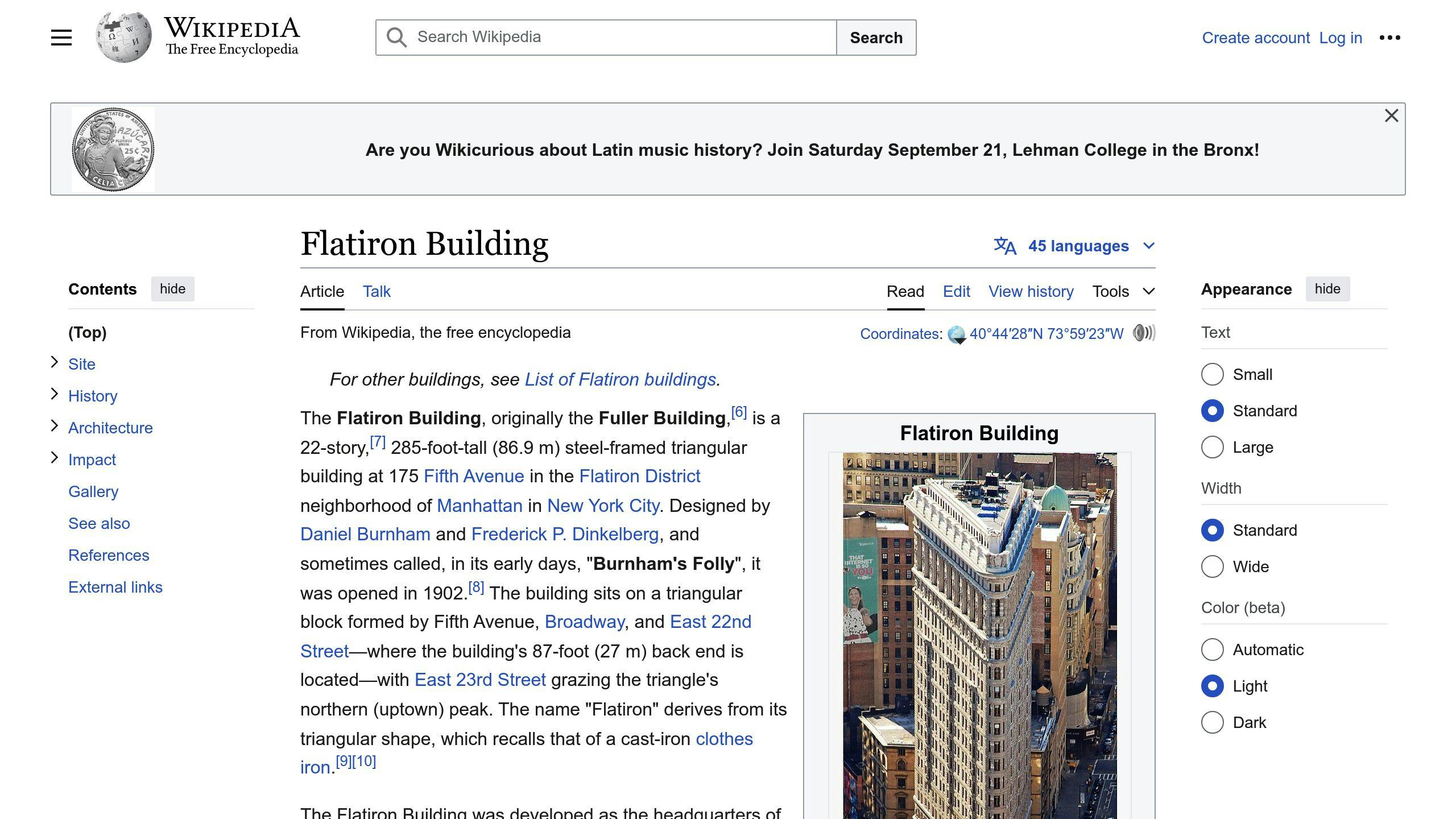
The Flatiron Building is a NYC icon. It's that weird wedge-shaped building at Fifth Avenue, Broadway, and 23rd Street.
Here's the deal:
Built in 1902, it's 285 feet tall (22 stories). Daniel Burnham designed it in Beaux-Arts and Renaissance Revival styles. And get this: it's only 6.5 feet wide at the top!
People called it "Flatiron" because it looks like an old-school iron. The name stuck.
It was one of NYC's first skyscrapers, thanks to its steel skeleton. The outside? Fancy limestone and terra-cotta with columns and gargoyles.
Check out these construction facts:
| Feature | Detail |
|---|---|
| Construction speed | One floor per week |
| Shape | Triangle with curved sides |
| Location | Manhattan's Flatiron District |
| Original use | Fuller Company offices |
Fun fact: They forgot to add women's bathrooms at first. Oops.
The building's shape created crazy wind tunnels. Guys would hang around hoping to see women's ankles when the wind blew their skirts up. Creepy, right? Cops would yell "23 skidoo" to shoo them away.
The Flatiron's been in tons of movies and art. It's officially a big deal:
-
NYC Landmark (1966)
-
National Register of Historic Places (1979)
-
National Historic Landmark (1989)
People hated it at first. The New York Times called it a "monstrosity." Now? Everyone loves it.
In 2023, Jeffrey Gural bought it for $161 million after some drama. It's getting a makeover, but it's still turning heads on the NYC skyline.
6. Guggenheim Museum
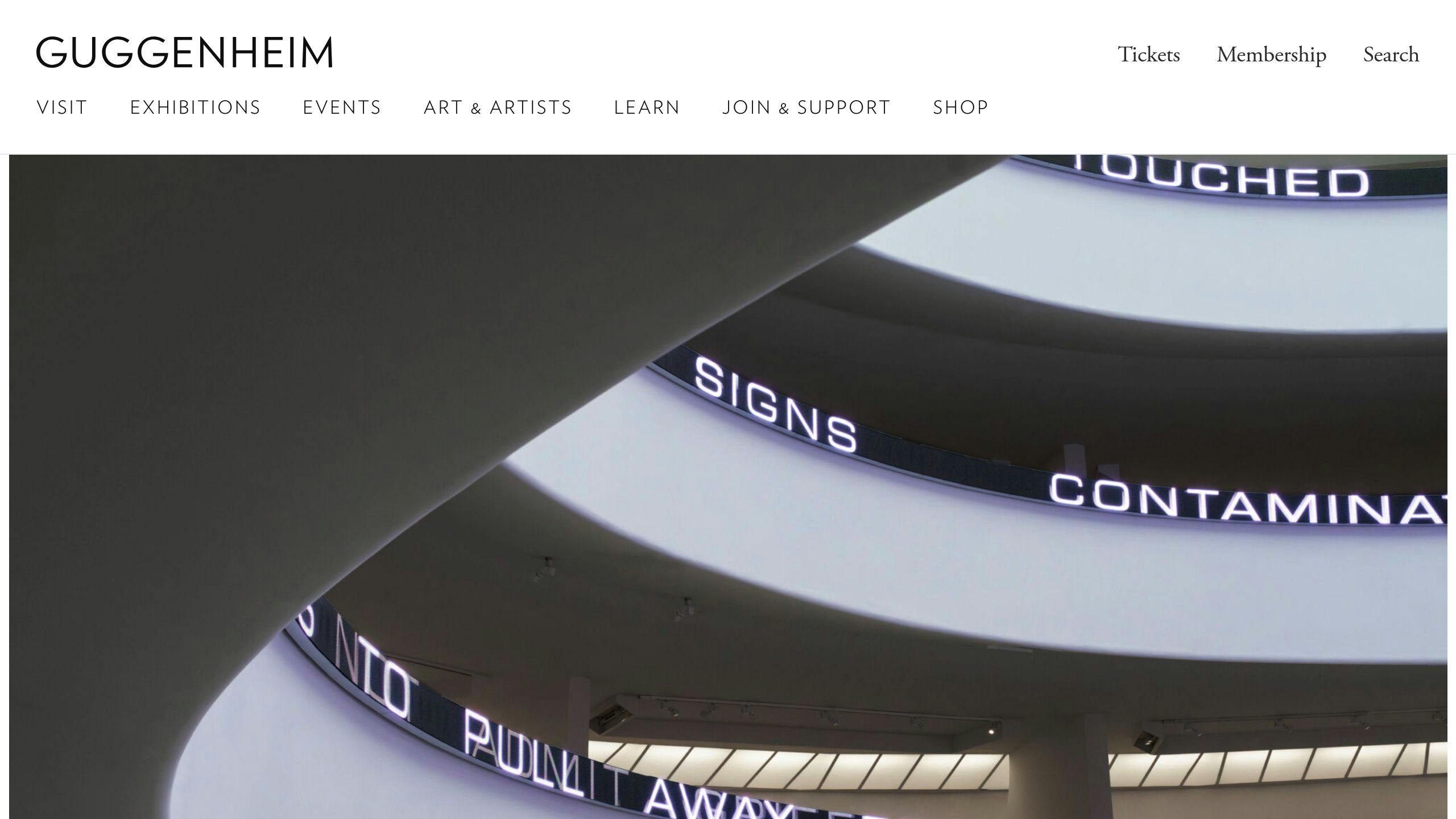
The Guggenheim Museum isn't your average NYC building. It's a giant white ribbon coiled into a cylinder, standing out in the city's skyline.
Frank Lloyd Wright, the architect behind this eye-catcher, took his sweet time with it. He started in 1943 and finished 16 years later. That's 700 sketches and 6 sets of working drawings!
Here's the Guggenheim timeline:
| Year | Event |
|---|---|
| 1943 | Design starts |
| 1959 | Museum opens |
| 1990-1992 | First big renovation |
| 2005-2008 | Second big renovation |
Sadly, Wright didn't see his creation come to life. He died just six months before it opened in 1959.
When it first showed up, people couldn't decide if they loved it or hated it. The New York Times said it got both praise and criticism for its weird shape.
"BELIEVE THAT BY CHANGING OUT IDEA OF A BUILDING FROM HORIZONTAL TO PERPENDICULAR WE CAN GO WHERE WE PLEASE." - Frank Lloyd Wright
Wright flipped the script on museum design. Instead of flat floors, he made a spiral ramp that winds up the building. It's like one big, continuous gallery.
You'll find the Guggenheim at 1071 5th Ave, right by Central Park. It's open most days from 11 AM to 6 PM, but stays up late till 8 PM on Saturdays.
Want to dodge the crowds? Show up at 11 AM when it opens, or around 4 PM when it's quieter. And skip Mondays - they're usually packed because other museums are closed.
The Guggenheim isn't just a pretty face. It's a modern art museum that wants to give you a personal experience. As you walk up that spiral, you're on a journey through art history.
7. Grand Central Terminal

Grand Central Terminal isn't just a train station. It's a slice of New York City history.
Built in 1913, this Beaux-Arts beauty replaced the old Grand Central Station. It's more than just a transport hub - it's a cultural icon.
What makes it special?
-
44 platforms (more than any other train station)
-
A starry ceiling with 2,500 twinkling lights
-
That famous clock at the Information Booth (worth up to $20 million!)
In 2018, nearly 22 million people visited Grand Central. That's not even counting train and subway riders! Back in 1947, it was even busier - 65 million people passed through DAILY.
The 1980s saw Grand Central get a facelift:
| What Changed | How It Changed |
|---|---|
| More shops | New places to eat and shop |
| Ceiling cleanup | That starry sky got a good scrub |
| New stairs | Added marble stairs to match the old ones |
But there's more to Grand Central than meets the eye. Ever heard of the Whispering Gallery? It's a spot where you can hear whispers from across the room. And don't forget the Oyster Bar - they serve up two million oysters every year!
"BELIEVE THAT BY CHANGING OUT IDEA OF A BUILDING FROM HORIZONTAL TO PERPENDICULAR WE CAN GO WHERE WE PLEASE." - Frank Lloyd Wright
Wright was talking about the Guggenheim, but he could've been describing Grand Central. It's not just a station - it's a vertical city.
During World War II, Grand Central stepped up. The government opened a USO branch inside, serving 40% of Americans who traveled through each year.
Today, Grand Central is still a big deal. Whether you're catching a train or just looking around, it's a must-see in NYC. It's where history meets the hustle and bustle of New York life.
sbb-itb-1be9014
8. St. Patrick's Cathedral

St. Patrick's Cathedral is a big deal in New York City. It's a massive Neo-Gothic church that's been part of the city since 1879.
Here's the quick and dirty on its history:
| Year | What Happened |
|---|---|
| 1858 | Started building |
| 1860 | Civil War put things on hold |
| 1865 | Back to work |
| 1879 | Doors open |
The cathedral's got some cool features:
-
Pointy arches
-
Fancy vaults
-
Tall spires
-
94 stained-glass windows
It's not just pretty - it's popular. About 5.5 million people visit each year. That's a lot of folks!
St. Patrick's has seen some big moments. JFK's funeral was here in 1963. The Pope dropped by in 1965.
In 2015, they spent $300 million to spruce it up. Now it's looking sharp.
Inside, you'll find:
-
A huge altar with a 57-foot bronze canopy
-
Big bronze doors
-
NYC's biggest organ (7,855 pipes!)
"St. Patrick's Cathedral is a big part of New York City's history and culture. It shows how important the Catholic faith is to many New Yorkers."
Movie trivia: Remember the baptism scene in The Godfather? That was filmed here.
So, whether you're into history, architecture, or just need a quiet spot in the city, check out St. Patrick's. It's more than just a church - it's a piece of New York.
9. The Metropolitan Museum of Art

The Met isn't just a museum. It's a time machine, art gallery, and history book rolled into one massive building in Central Park.
| Founded | Opened | Location | Collection Size | Annual Visitors |
|---|---|---|---|---|
| 1870 | 1880 | Central Park | 2 million+ works | ~7 million |
The building itself? It's grown like a living thing:
-
1880: Original Victorian Gothic structure
-
Later: Expansions added, mixing old and new styles
Inside, you'll find EVERYTHING. Ancient Egyptian temples? Check. George Washington crossing the Delaware? Yep. Kids gawking at medieval armor? You bet.
When to go:
-
Sunday–Tuesday, Thursday: 10 am–5 pm
-
Friday, Saturday: 10 am–9 pm
-
Closed: Wednesdays, some holidays
Pro tip: Use the street-level entrance. It's less crowded.
Short on time? The Met's got you covered with 1, 3, or 8-hour itineraries. Or splurge on a guided tour ($63+) to skip the lines.
"You don't have to have an extensive art background to appreciate art", say the Met's archives.
What's next? A new wing by Frida Escobedo - the first woman to design for the Met in its 154-year history.
The Met isn't just a place to see art. It's where you'll see humanity's entire creative journey under one roof.
10. Brooklyn Bridge

The Brooklyn Bridge isn't just a river crossing—it's a walkable piece of NYC history.
Built in 1883, this steel-wire suspension bridge was the first of its kind. It stretches 1,595.5 feet over the East River, linking Manhattan and Brooklyn. When it opened, only Trinity Church's spire topped its 268-foot towers.
| Feature | Measurement |
|---|---|
| Total length | 5,989 feet |
| Main span | 1,595.5 feet |
| Tower height | 268 feet |
The bridge's backstory is as impressive as its structure. John A. Roebling designed it but died before construction. His son Washington took over, then fell ill. Washington's wife Emily stepped in, becoming the bridge's unofficial chief engineer.
"The completed work... will not only be the greatest bridge in existence, but it will be the greatest engineering work of the continent, and of the age." - John A. Roebling
Today, the Brooklyn Bridge sees over 100,000 vehicles, 4,000 cyclists, and 10,000 pedestrians daily. It's both a busy route and a tourist hotspot.
Want to cross it yourself? Here's the scoop:
-
It's a 1.1-mile walk one-way
-
Allow 30+ minutes each way
-
Start from Manhattan for the best Brooklyn views
-
Beat the crowds: go before 8 am or later in the day
-
Stay in the pedestrian lane—cyclists have their own
In 2019, the bridge got a $337 million facelift, fixing structural issues and boosting earthquake resistance. It's now set for many more years of connecting New Yorkers and amazing visitors.
11. Rockefeller Center
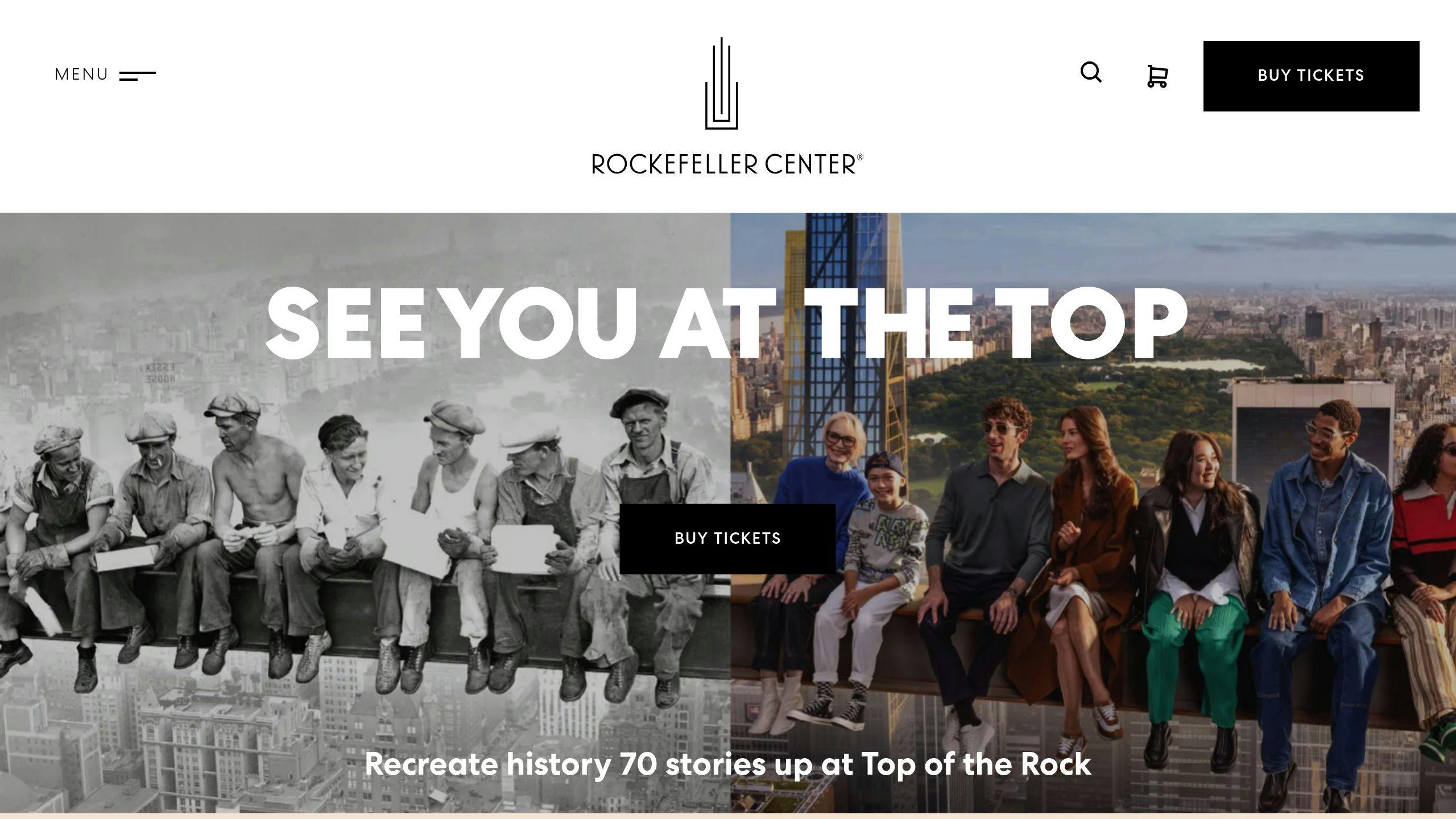
Rockefeller Center is a big deal in NYC. It's a 22-acre complex in Midtown Manhattan that John D. Rockefeller Jr. dreamed up in the 1920s.
They built it from 1930 to 1939, right during the Great Depression. It gave jobs to 40,000 people when work was hard to find. Now, it's got 19 buildings, with 30 Rockefeller Plaza as the star of the show.
| Feature | Details |
|---|---|
| Total area | 22 acres |
| Number of buildings | 19 |
| Main building | 30 Rockefeller Plaza |
| Construction period | 1930-1939 |
| Architectural style | Art Deco |
30 Rock (that's what people call 30 Rockefeller Plaza) is 849 feet 9 inches tall with 70 floors. Want a killer view of NYC? Head to the "Top of the Rock" observation deck on the 67th, 69th, and 70th floors.
Cool stuff at Rockefeller Center:
-
Radio City Music Hall: It's HUGE. 6,000 seats huge.
-
The Rink: People love it. 250,000 skaters visit every year.
-
Christmas Tree: The lighting ceremony is a big deal. Tons of people watch it live and on TV.
Want to learn more? Take the Rockefeller Center Tour. It's $27, or $56 if you want to hit up Top of the Rock too.
"Art was an act of good citizenship." - Raymond Hood, Architect
This quote shows why there's so much art all over the place.
Rockefeller Center keeps changing. In 1985, the Rockefeller Group bought the land from Columbia University for $400 million. That's a lot of cash, but it means this NYC icon isn't going anywhere.
12. The High Line

The High Line isn't your average park. It's a 1.5-mile-long slice of urban renewal that's transformed Manhattan's West Side.
Built on an old railroad track, this elevated park faced its share of challenges. But thanks to community activism and public-private teamwork, it became a reality.
| High Line Facts | Details |
|---|---|
| Length | 1.5 miles |
| Opening | First section in 2009 |
| Completion | Final section in 2014 |
| Cost | $187 million |
| City's contribution | $123 million |
From West 14th to 30th Street, the High Line wraps around Hudson Yards. It's not just a park - it's a time capsule. Trees grow between rusted tracks, reminding visitors of its railway past. And the views? You can't beat the city skyline and Hudson River vistas.
"The High Line went viral, and cities worldwide have been rushing to turn their obsolete infrastructure into public space — trying to spur a revitalizing 'High Line effect' of their own." - Elizabeth Diller, Architect
But there's more. The High Line doubles as an outdoor museum, with ever-changing art installations. The newest section, the Spur, opened in 2021 with a 16-foot-tall bust by artist Simone Leigh.
The park's impact? HUGE. It's sparked a real estate boom nearby. Initial estimates of $250 million in increased city tax revenue were later bumped up to $900 million by 2038.
Want to experience it yourself? A full walk takes about 30 minutes - not counting stops for the views or art. It's a hit with locals and tourists alike, offering a green escape above New York's bustling streets.
13. United Nations Headquarters
The UN Headquarters in New York City is a big deal. It's where global diplomacy happens. Let's break it down:
-
Location: 18 acres in Manhattan's Turtle Bay
-
Opened: 1952
-
Design: International team led by Wallace Harrison
The complex has four main buildings:
| Building | What's Inside |
|---|---|
| General Assembly | Big 1,800-seat hall |
| Secretariat | 39-story office tower |
| Conference Building | Security Council chambers |
| Dag Hammarskjöld Library | 400,000+ books, 80,000+ maps |
The Secretariat Building? It's a glass giant. First of its kind in New York.
Oscar Niemeyer, one of the designers, said:
"When we make a building for the UN, we must have in mind what is the UN? It is an organization to set the nations of the world in a common direction and gives to the world security. I think it is difficult to get this into steel and stone."
Want to visit? Here's the scoop:
-
Tours: Monday to Friday, 45-60 minutes
-
Languages: All six official UN languages
-
Cost: $26 for adults
-
Tip: Show up an hour early (security's tight)
You'll see the General Assembly Hall, Security Council Chamber, and more.
Outside, check out the "Knotted Gun" sculpture. It's all about peace. And those flags? One for each of the 193 UN member states.
Heads up: The UN plays by its own rules, not U.S. law. Bring ID from a UN Member or Observer State.
Pro tip: Grab a $1 UN passport at the gift shop. Free stamp included!
Building Comparison
New York City's skyline is a mix of old and new. Let's look at some famous buildings:
| Building Name | Height (feet) | Style | Year |
|---|---|---|---|
| One World Trade Center | 1,776 | Modern | 2014 |
| Central Park Tower | 1,550 | Modern | 2020 |
| Empire State Building | 1,454 | Art Deco | 1931 |
| 30 Hudson Yards | 1,268 | Modern | 2019 |
| Chrysler Building | 1,046 | Art Deco | 1930 |
| Woolworth Building | 792 | Neo-Gothic | 1912 |
| Flatiron Building | 285 | Beaux-Arts | 1902 |
| Statue of Liberty | 305 | Neoclassical | 1886 |
What does this tell us? A lot, actually.
First, height. One World Trade Center tops the list at 1,776 feet. That's not random - it's a nod to 1776, the year America declared independence. Clever, right?
Next, style. See how it changes over time? Early 1900s had Beaux-Arts (Flatiron) and Neo-Gothic (Woolworth). The 1930s loved Art Deco (Empire State, Chrysler). Now? It's all about modern design.
Age-wise, the Statue of Liberty is the grandpa here (1886). The new kid on the block? Central Park Tower (2020).
Fun fact: The Empire State Building was the world's tallest for almost 40 years. Now it's not even New York's tallest. Talk about a fall from grace!
But here's the thing: Each building is a chapter in New York's story. From the quirky Flatiron to the towering One World Trade Center, they show how the city's grown up over a century.
So next time you're in New York, look up. You're not just seeing buildings. You're seeing history.
Wrap-up
NYC's skyline? It's a 150-year architectural story. From the 1889 Tower Building to today's sky-piercing giants, it's a mix of styles and innovation.
Here's a quick rundown of the city's building styles:
| Style | Period | Features | Example |
|---|---|---|---|
| Federal | Late 18th - Early 19th | Square, low-hipped roofs | 77 Bedford Street (1799) |
| Greek Revival | Early-Mid 19th | White, bold, columns | St. Mark's Church |
| Gothic Revival | Mid 19th | Pointed arches, medieval | St. John the Divine |
| Beaux-Arts | Late 19th - Early 20th | Symmetry, ornate | Grand Central Terminal |
| Art Deco | 1920s-1940s | Geometric, rich ornaments | Chrysler Building |
| Modern | Mid 20th onwards | Glass towers, sleek | One World Trade Center |
Why do these buildings stick around? A few reasons:
1. History: Each building tells a piece of New York's story. Take the Empire State Building - it was the world's tallest for 40 years.
2. Tech Breakthroughs: Steel frames and elevators? They made skyscrapers possible and changed cities forever.
3. Cultural Icons: These buildings are New York. They're America. People know them worldwide.
4. Variety: The mix of styles? It's New York's history and culture in brick and steel.
What's new in New York architecture?
-
Super-tall buildings (One World Trade Center hits 1,776 feet)
-
Green design (energy-efficient, eco-friendly materials)
-
Flexible spaces (buildings that adapt to changing needs)
Carol Willis, who started New York's Skyscraper Museum, puts it well:
"When you're at that elevated height, you see the collective city, but you also see, in some cases, the curvature of the earth."
That's why these buildings keep us looking up. They're not just structures. They're New York's story, reaching for the sky.
Tips for Visiting
Want to see New York's iconic buildings? Here's how to do it right:
1. Beat the crowds
Hit the Empire State Building early or late. For Top of the Rock? Sunset's your best bet.
2. Go high
One World Observatory gives you views from way up. Or try the Edge at Hudson Yards - it's the highest outdoor deck around.
3. Get on the water
Take the free Staten Island Ferry. You'll see Lower Manhattan and Lady Liberty. Tip: stand on the right when leaving for the best views.
4. Walk the Brooklyn Bridge
Do it at sunrise. You'll get great skyline views without the crowds.
5. Food and architecture
Try the Flatiron Food and Architecture Tour. It's a 3-hour mix of local eats and building facts.
6. Save some cash
Look into a New York CityPASS®. It can make your trip cheaper.
7. Skip the car
New York traffic is a nightmare. Use public transport instead. Get a MetroCard and download a subway map.
8. Comfy shoes are key
You'll walk. A lot. Make sure your shoes are broken in.
9. Plan ahead
Want a rooftop bar with a view? Book it early.
10. Get a guide
For Midtown's architecture, a private walking tour can be worth it. You'll see inside some buildings and learn the area's history.
